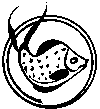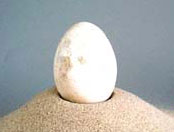 |
| Turiang |
26 Mar 2001
|
|||
| Last modified: 26 Mar 2001 |
One of the Thai storage jars found on the
forward port side contained fishbones. Everything else relating to the
crew was aft, and the fish are thought to have been part of the commercial cargo(1).
These bones are similar to others found in nine large martabans on the Royal
Nanhai,  and
there are equally large jars in the equivalent position on the Turiang
which have yet to be investigated. The Royal Nanhai bones were identified
as mackerel of the Rastrelliger genus.(2)
The three species of this genus have all been caught in the South China Sea,
and the bones best fit those of Rastrelliger brachysoma. This fish lives
in saltwater or the brackish water of river deltas, and remains popular for
eating. The forklength is 16-18cm. The remains do not include gills, which must
have been removed in order to salt, dry or smoke the fish. Rastrelliger
bones also predominate in the Turiang sample, which includes some bones
from another fish species yet to be identified.
and
there are equally large jars in the equivalent position on the Turiang
which have yet to be investigated. The Royal Nanhai bones were identified
as mackerel of the Rastrelliger genus.(2)
The three species of this genus have all been caught in the South China Sea,
and the bones best fit those of Rastrelliger brachysoma. This fish lives
in saltwater or the brackish water of river deltas, and remains popular for
eating. The forklength is 16-18cm. The remains do not include gills, which must
have been removed in order to salt, dry or smoke the fish. Rastrelliger
bones also predominate in the Turiang sample, which includes some bones
from another fish species yet to be identified.
 Eggs
were also found in a storage jar - aft, where the cooking facilities may have
been (C-01 on the site plan). One unbroken egg, marred only by two pinholes,
was brought to the surface.
Eggs
were also found in a storage jar - aft, where the cooking facilities may have
been (C-01 on the site plan). One unbroken egg, marred only by two pinholes,
was brought to the surface.
Small chunks of sphalerite or zinc blende were found in ten storage
jars, all similar to the jar with the fishbones.  These
jars were found some distance outside the hull, dragged out by trawlers, suggesting
that they were stored on deck or in the upper layers of the cargo. Sphalerite
has a resinous lustre; it contains zinc sulfide (ZnS), and is mined in many
parts of the world, including currently near Chiang Mai in northern Thailand.
Sphalerite has thin shiny flakes which are easily crumbled; the resultant powder
is not only 'glitter', but sticks readily to the skin, and may have been used
as makeup.
These
jars were found some distance outside the hull, dragged out by trawlers, suggesting
that they were stored on deck or in the upper layers of the cargo. Sphalerite
has a resinous lustre; it contains zinc sulfide (ZnS), and is mined in many
parts of the world, including currently near Chiang Mai in northern Thailand.
Sphalerite has thin shiny flakes which are easily crumbled; the resultant powder
is not only 'glitter', but sticks readily to the skin, and may have been used
as makeup.
Large lumps of iron oxide were found inside the wreck area, and also outside, dragged by modern fishing nets. Similar iron oxide conglomerate lumps were found on the Royal Nanhai, as well as bar-shaped iron ingots (not recovered because fused together). The lumps are red-brown on the inside and whitish on the outside, and are thought to derive from iron ore carried as cargo in granular form. No ingots of any kind have yet been found on the Turiang. Iron in seawater forms sprawling concretions, and some of the lumps have enveloped ceramics. The iron conglomerate on the Royal Nanhai was associated with traces of flattened bamboo, suggesting to the investigators that it had originally been packed in bamboo bags; it appeared to have trickled down from higher levels as these deteriorated after the ship sank. Iron or iron ore has been found on other historic wrecks in the region, and appears to have been a common cargo item.
One shaped stone was found, 23.5cm long and 15cm wide, with marks suggesting it was used for sharpening knives.
At least four elephant tusks were noted on the seabed, but were too decomposed to be brought to the surface.
No anchors have yet been found, on the Turiang or any of the other wrecks, including the Royal Nanhai which has been almost fully excavated.
| Turiang overview | Maritime Asia homepage | Next: Dating |